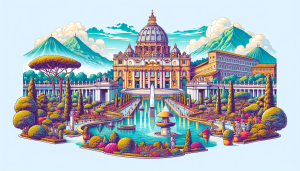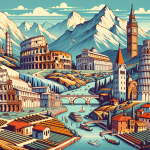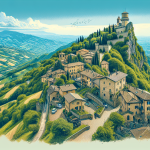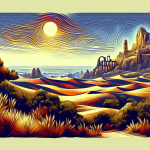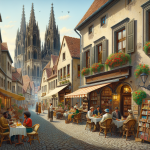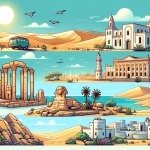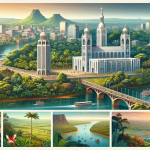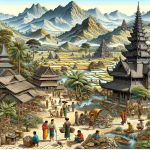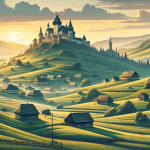Vatican City: A Majestic Journey Through History, Art, and Spirituality
Vatican City, the smallest independent state in the world, is a treasure trove of unparalleled history, art, and spirituality. Nestled within the bustling city of Rome, Vatican City is not just a destination for devout pilgrims but also a magnet for art enthusiasts, historians, and curious travelers from across the globe. With its awe-inspiring architecture, priceless art collections, and profound spiritual significance, Vatican City offers a unique and enriching experience. This article delves into the wonders of Vatican City, exploring its key attractions, historical significance, and tips for making the most of your visit. Whether you’re planning a trip or simply fascinated by this extraordinary enclave, read on to uncover the hidden gems and timeless allure of Vatican City.
A Brief History of Vatican City
Vatican City’s origins can be traced back to the early days of Christianity. The area where Vatican City now stands was once part of the ancient Roman Empire and was considered a sacred place due to its association with Saint Peter, one of Jesus Christ’s apostles and the first Pope. Over the centuries, Vatican City evolved into the spiritual and administrative heart of the Roman Catholic Church. In 1929, the Lateran Treaty established Vatican City as an independent sovereign state, distinct from Italy. This unique status has allowed the Vatican to maintain its autonomy and preserve its rich cultural and religious heritage.
The Formation of Vatican City
The Lateran Treaty, signed by Benito Mussolini and Cardinal Secretary of State Pietro Gasparri, marked the formal establishment of Vatican City as an independent state. The treaty resolved long-standing disputes between the Papacy and the Italian government, granting the Vatican full sovereignty and ensuring the Pope’s independence in spiritual matters. This agreement also defined the boundaries of Vatican City, encompassing approximately 110 acres of land, making it the smallest internationally recognized independent state in the world.
Vatican City’s Role in the Roman Catholic Church
As the epicenter of the Roman Catholic Church, Vatican City plays a crucial role in the global religious community. It serves as the residence of the Pope, the spiritual leader of over one billion Catholics worldwide. The Vatican is also home to the Curia, the administrative body responsible for the day-to-day operations of the Church. Additionally, Vatican City hosts numerous important religious events, including Papal audiences, Masses, and ceremonies. Its influence extends beyond religious matters, as the Vatican often engages in diplomatic efforts and promotes humanitarian causes on the international stage.
Exploring the Iconic Landmarks of Vatican City
Vatican City boasts a wealth of iconic landmarks that draw millions of visitors each year. From the grandeur of St. Peter’s Basilica to the artistic treasures of the Vatican Museums, there is no shortage of awe-inspiring sights to explore. Here are some of the must-visit attractions within Vatican City:
St. Peter’s Basilica: A Masterpiece of Renaissance Architecture
St. Peter’s Basilica, one of the largest churches in the world, is a masterpiece of Renaissance architecture. Designed by renowned architects such as Michelangelo, Bernini, and Bramante, the basilica is an architectural marvel adorned with stunning artworks and intricate details. Visitors can marvel at Michelangelo’s iconic dome, which offers breathtaking views of Rome from its summit. Inside the basilica, the grandeur continues with the awe-inspiring altar, Bernini’s Baldacchino, and the Pietà, one of Michelangelo’s most famous sculptures.
The Vatican Museums: A Treasure Trove of Art and History
The Vatican Museums house one of the most extensive and impressive art collections in the world. Established by Pope Julius II in the early 16th century, the museums feature works from various periods, including ancient Roman and Egyptian artifacts, Renaissance masterpieces, and contemporary art. Highlights of the Vatican Museums include the Raphael Rooms, adorned with frescoes by Raphael, and the Gallery of Maps, showcasing stunning cartographic representations. However, the crown jewel of the Vatican Museums is undoubtedly the Sistine Chapel, renowned for Michelangelo’s breathtaking ceiling frescoes and The Last Judgment.
The Sistine Chapel: Michelangelo’s Masterpiece
The Sistine Chapel, located within the Apostolic Palace, is one of the most famous and revered chapels in the world. Michelangelo’s frescoes, which cover the chapel’s ceiling and altar wall, are considered some of the greatest achievements in Western art. The ceiling frescoes depict scenes from the Book of Genesis, including the iconic Creation of Adam, while The Last Judgment on the altar wall portrays the final judgment of souls. The Sistine Chapel also serves as the site of the Papal Conclave, where cardinals gather to elect a new Pope.
St. Peter’s Square: A Gathering Place for Pilgrims and Tourists
St. Peter’s Square, designed by Gian Lorenzo Bernini, is a grand and welcoming space that serves as the entrance to St. Peter’s Basilica. The square is flanked by massive colonnades, symbolizing the embracing arms of the Church. At its center stands the ancient Egyptian obelisk, brought to Rome by Emperor Caligula. St. Peter’s Square is a gathering place for pilgrims and tourists, especially during Papal audiences and important religious events. The square’s open and inviting design creates a sense of unity and community among visitors from around the world.
Practical Tips for Visiting Vatican City
Planning a visit to Vatican City requires some preparation to make the most of your experience. Here are some practical tips to ensure a smooth and enjoyable visit:
Best Time to Visit Vatican City
The best time to visit Vatican City is during the shoulder seasons of spring (April to June) and fall (September to October). During these months, the weather is mild, and the crowds are relatively smaller compared to the peak summer season. If you prefer a quieter experience, consider visiting early in the morning or later in the afternoon, as these times tend to be less crowded.
Dress Code and Etiquette
Vatican City has a strict dress code, especially when entering religious sites such as St. Peter’s Basilica and the Sistine Chapel. Visitors should dress modestly, with shoulders and knees covered. Avoid wearing hats inside religious buildings, and maintain a respectful demeanor. Photography is allowed in most areas of Vatican City, but flash photography and tripods are generally prohibited inside the Vatican Museums and the Sistine Chapel.
Guided Tours and Skip-the-Line Tickets
To make the most of your visit, consider joining a guided tour or purchasing skip-the-line tickets. Guided tours offer valuable insights into the history and significance of the landmarks, enhancing your overall experience. Skip-the-line tickets can save you hours of waiting in long queues, especially during peak tourist seasons. Many tours also include access to restricted areas, such as the Vatican Gardens and the Necropolis, providing a more comprehensive exploration of Vatican City.
Exploring Beyond Vatican City
While Vatican City itself is a treasure trove of wonders, don’t miss the opportunity to explore the surrounding areas of Rome. The Eternal City offers a wealth of historical and cultural attractions, from the Colosseum and Roman Forum to the Pantheon and Trevi Fountain. A visit to Vatican City can be seamlessly combined with a broader exploration of Rome, allowing you to immerse yourself in the rich tapestry of history and art that this ancient city has to offer.
The Spiritual Significance of Vatican City
Vatican City holds profound spiritual significance for millions of Catholics worldwide. It is not only the residence of the Pope but also the center of the Roman Catholic Church. Pilgrims from all corners of the globe travel to Vatican City to deepen their faith, seek spiritual guidance, and participate in religious ceremonies. The spiritual atmosphere of Vatican City is palpable, offering a sense of peace and reverence to all who visit.
Papal Audiences and Blessings
One of the unique experiences for visitors to Vatican City is attending a Papal audience or receiving a Papal blessing. Papal audiences are held on Wednesday mornings, where the Pope addresses the crowd and offers blessings. These events are open to the public, but tickets are required, which can be obtained for free through the Prefecture of the Papal Household. Attending a Papal audience provides a rare opportunity to see the Pope up close and receive his blessings.
Holy Mass at St. Peter’s Basilica
Participating in a Holy Mass at St. Peter’s Basilica is a deeply spiritual experience. Masses are held daily, with special services on Sundays and religious holidays. Attending Mass at the basilica allows visitors to connect with the rich liturgical traditions of the Catholic Church and experience the grandeur of one of the world’s most magnificent churches. While participation in the Mass is free, it is advisable to arrive early to secure a seat, especially during major religious celebrations.
Pilgrimage to the Tomb of Saint Peter
For many Catholics, a pilgrimage to the tomb of Saint Peter is a deeply meaningful journey. The tomb is located beneath the main altar of St. Peter’s Basilica, in the Necropolis. Visits to the Necropolis are limited and require advance reservations, but the experience is profoundly moving. Pilgrims have the opportunity to pay their respects to the apostle who is considered the foundation of the Church and reflect on their faith in this sacred space.
The Vatican’s Artistic and Cultural Heritage
Vatican City’s artistic and cultural heritage is unparalleled, with an extensive collection of priceless artworks and historical artifacts. The Vatican Museums, the Sistine Chapel, and St. Peter’s Basilica are just a few examples of the Vatican’s commitment to preserving and showcasing its rich cultural legacy. The Vatican’s art collections span centuries and include works by some of the most renowned artists in history.
Raphael Rooms: A Renaissance Masterpiece
The Raphael Rooms, located within the Vatican Museums, are a series of rooms adorned with frescoes by the Italian Renaissance artist Raphael. These frescoes, commissioned by Pope Julius II, depict various religious and historical scenes, showcasing Raphael’s mastery of composition and color. The most famous of these rooms is the Stanza della Segnatura, which features the iconic fresco The School of Athens, representing the gathering of great philosophers and scholars.
The Vatican Library: A Treasure Trove of Knowledge
The Vatican Library, one of the oldest libraries in the world, is a treasure trove of knowledge and history. Established in the 15th century, the library houses an extensive collection of manuscripts, books, and documents, including rare and ancient texts. The Vatican Library’s collection spans a wide range of subjects, from theology and philosophy to science and literature. While the library is not open to the general public, scholars and researchers can access its vast resources by appointment.
The Vatican Gardens: A Serene Oasis
The Vatican Gardens, covering approximately half of Vatican City’s territory, offer a serene and picturesque escape from the bustling city. These beautifully landscaped gardens feature a variety of plants, flowers, and fountains, reflecting the Vatican’s commitment to preserving nature’s beauty. Guided tours of the Vatican Gardens are available, providing visitors with the opportunity to explore this peaceful oasis and enjoy stunning views of St. Peter’s Basilica and the surrounding cityscape.
Conclusion: The Timeless Allure of Vatican City
Vatican City, with its rich history, artistic treasures, and profound spiritual significance, is a destination that captivates and inspires visitors from all walks of life. Whether you are drawn to its architectural marvels, its world-renowned art collections, or its deep religious heritage, Vatican City offers an unforgettable experience that resonates on multiple levels. As you explore the grandeur of St. Peter’s Basilica, the artistic wonders of the Vatican Museums, and the serene beauty of the Vatican Gardens, you will undoubtedly be touched by the timeless allure of this extraordinary enclave. Plan your visit to Vatican City, and embark on a journey that will leave you with lasting memories and a deeper appreciation for the richness of human achievement and the power of faith.
For more information on visiting Vatican City, you can visit the official Vatican website.
